
One of the first things I learned to cook was ravioli. Initially, it was less “cook” than “assist in the preparation of,” which my family would do every Thanksgiving and/or Christmas, rolling out dozens of little meat-cheese-and-herb filled pasta dumplings, that were generally far more coveted than the inevitably dry-ass turkey. My grandma or great aunt would then serve them, slathered in a heavy red meat sauce that had been simmering for hours, with a thin film of orange grease on the top, as seen in virtually every mob movie ever made.
I still make ravioli (you can say “ravioli” or “raviolis,” the “i” makes it plural in Italian) every year with my own kids. Partly to maintain the tradition, and partly because I just like eating them. I’m a firm believer that the team production effort makes them taste better.
We did, and do, always make them basically the same way: cook the meat (ground beef, usually, maybe with some other ground meat in there too) for the filling in a pan, mix it with herbs, cheese, and/or greens (spinach or swiss chard), let it cool, and then use the mixture it to fill the little scalloped-edged ravioli squares. Most of the recipes I’ve researched online seem to describe basically this same method.
This is partly why I was surprised to find, when I worked in the kitchen of a Chinese restaurant in college, that they never cooked the meat before it went in the dumplings. Pork, shrimp, or chicken — it always went into the little potsticker rounds raw. And, much like my grandmother’s holiday ravioli, they nearly always were boiled from frozen without defrosting first. (If you don’t freeze the ravioli, you have to cook them the same day, or else the pasta dough will start to turn green. It usually happens within 12 hours, even when refrigerated. I’m not sure if this is also true for eggless doughs. In any case, freezing keeps them from turning green.)
Looking around the internet for dumpling recipes, it seems this is how most meat dumplings are made, across varied cultures — gyoza, shumai, pelmeni, mantu, momo… — the list goes on, but raw meat seems to be the norm. My rough poll of fellow Uproxx Life writers Steve Bramucci and Zach Johnston revealed similar experiences; learning, and continuing to make, ravioli with cooked meat filling, even as we’d learned many other types of dumplings using raw meat.
Which made me wonder: have Italian-Americans always been making ravioli by cooking the meat first, and if so, why? I follow a lot of Top Chefs on Instagram, so I reached out to the two I see making ravioli most often, Joe Sasto and Joe Flamm (clearly, I was hoping to hear from a diverse cross-section of chefs named Joe). I asked Flamm, the season 15 winner and current chef/owner of Rose Mary in Chicago, about it, and he told me “Yeah, so that’s funny: actually we do cook the meat and always have in all the Italian food I’ve ever done. Stuffing raw meat wasn’t something I saw until I worked at a Korean BBQ spot and made the dumplings and they were all raw meat. We still make them, and still cook the meat.”
Clearly, my experience here was not an outlier, cooking meat for ravioli even while learning a variety of raw meat-and-dough dumplings. Next, I asked Sasto, also a season 15 competitor, who currently runs a few pop-ups and cooking classes, if he always cooks the meat for his ravioli and stuffed pastas, and got a different answer.
“Definitely not,” Sasto said. “It depends on the desired shape, filling, texture, and result you’re looking for.”
I asked if cooked was how he’d first learned it, and he said no, actually. His first stuffed pasta was a traditional tortellini with raw ground pork and mortadella.
If you can use raw pork in a tortellini, it would stand to reason that you can use raw meat in a ravioli. And if it’s possible, why isn’t it standard? Since I couldn’t exactly answer that one with a poll, I figured the best way was just to make some that way and compare the results and the process. I already had the necessary ingredients in the fridge.
To start, I mixed up some dough using my usual ratio — three eggs, three yolks, two cups of 00 flour, and a little olive oil, which I prefer to mix up in a food processor since that seems to be the fastest method (your own dough ratio will vary based on egg size, flour type, and climate). For the filling, I used what I already had in the fridge: ground beef, ricotta, grated raw garlic, Parmigiano reggiano (24 month-aged), parsley, and eggs.
Fairly similar to what you’d put in an Italian meatball.

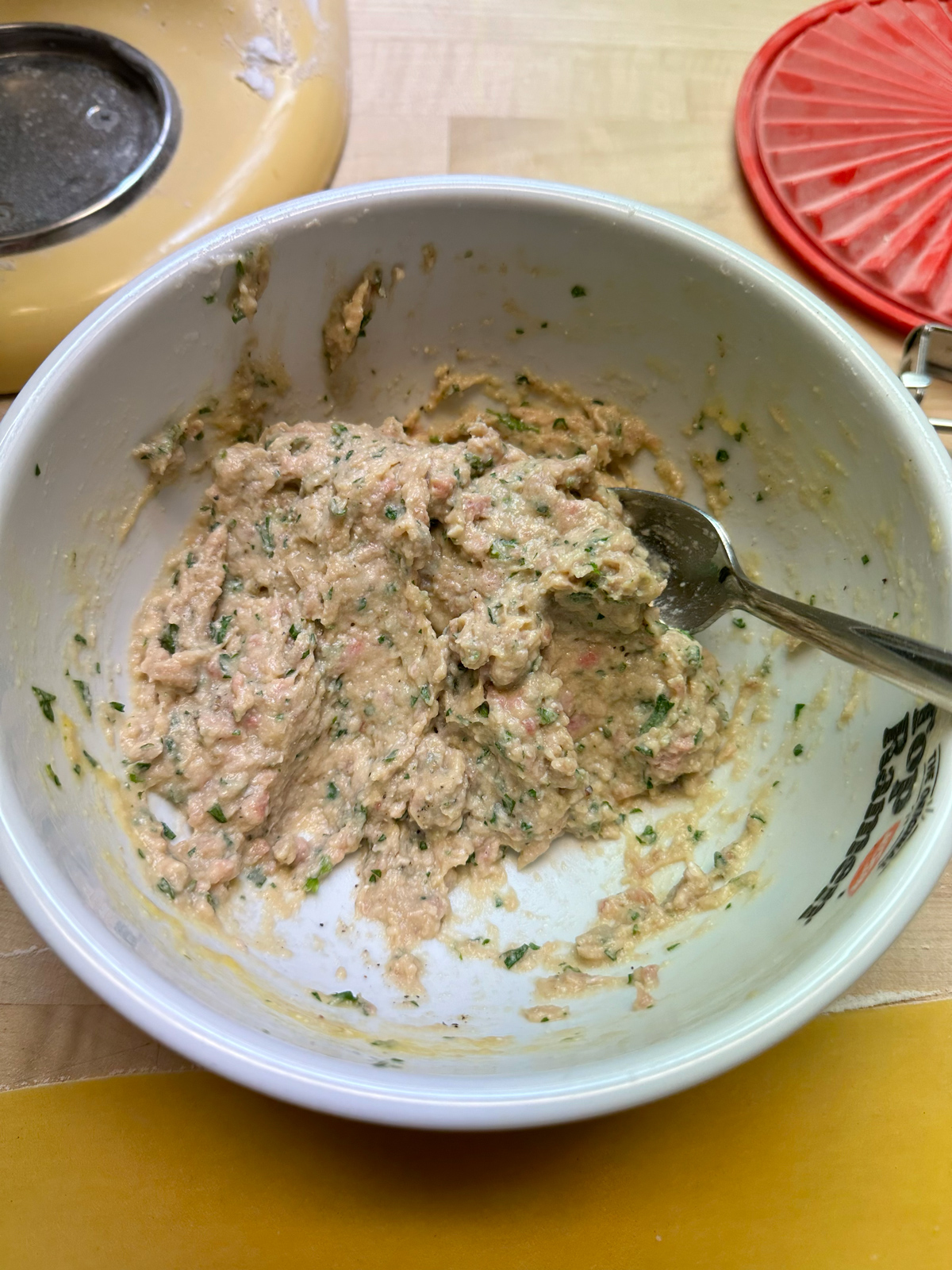
From there I made them more or less the way I always do — rolling the dough out in the machine, then laying it across my metal ravioli press. I rolled the sheets out to number seven thinness on my machine (which goes up to 8). I usually go thinner for ravioli than other pasta because the edges will be two sheets pressed together.
One thing I noticed right off the bat with the raw method was that the filling stayed a little more uniform in its raw form; a little less crumbly than the cooked version, which made the filling process a little easier. They made nice little gelatinous balls (also my nickname in high school).
I suppose I could’ve even used a piping bag, though I didn’t. Just a small spoon.
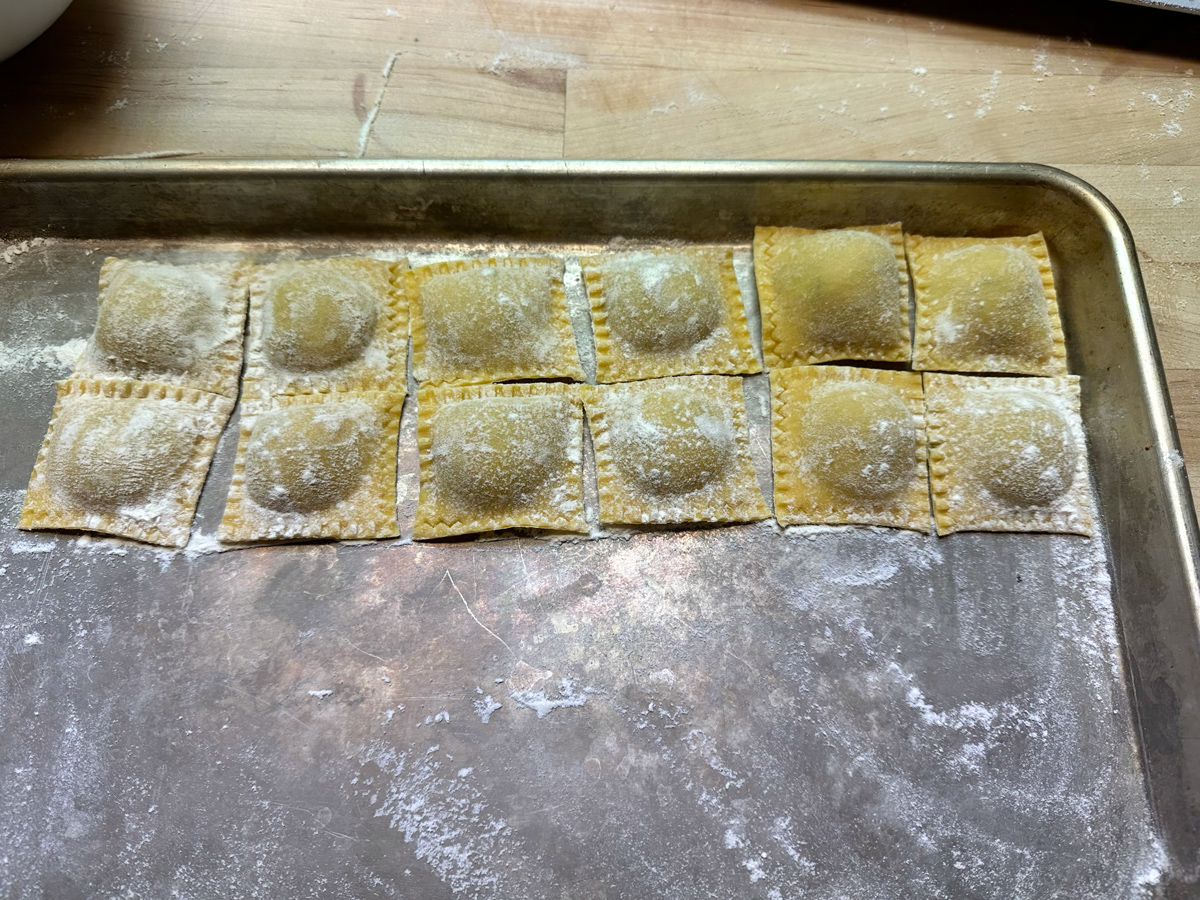
To cook them, I, again, just threw them in a pot of boiling salty water (I read somewhere, I think it was Samin Nosrat, that salting the dough can make it tougher, so I compensate with saltier cooking water. To be honest I’ve never noticed much difference in texture between salted and unsalted dough).
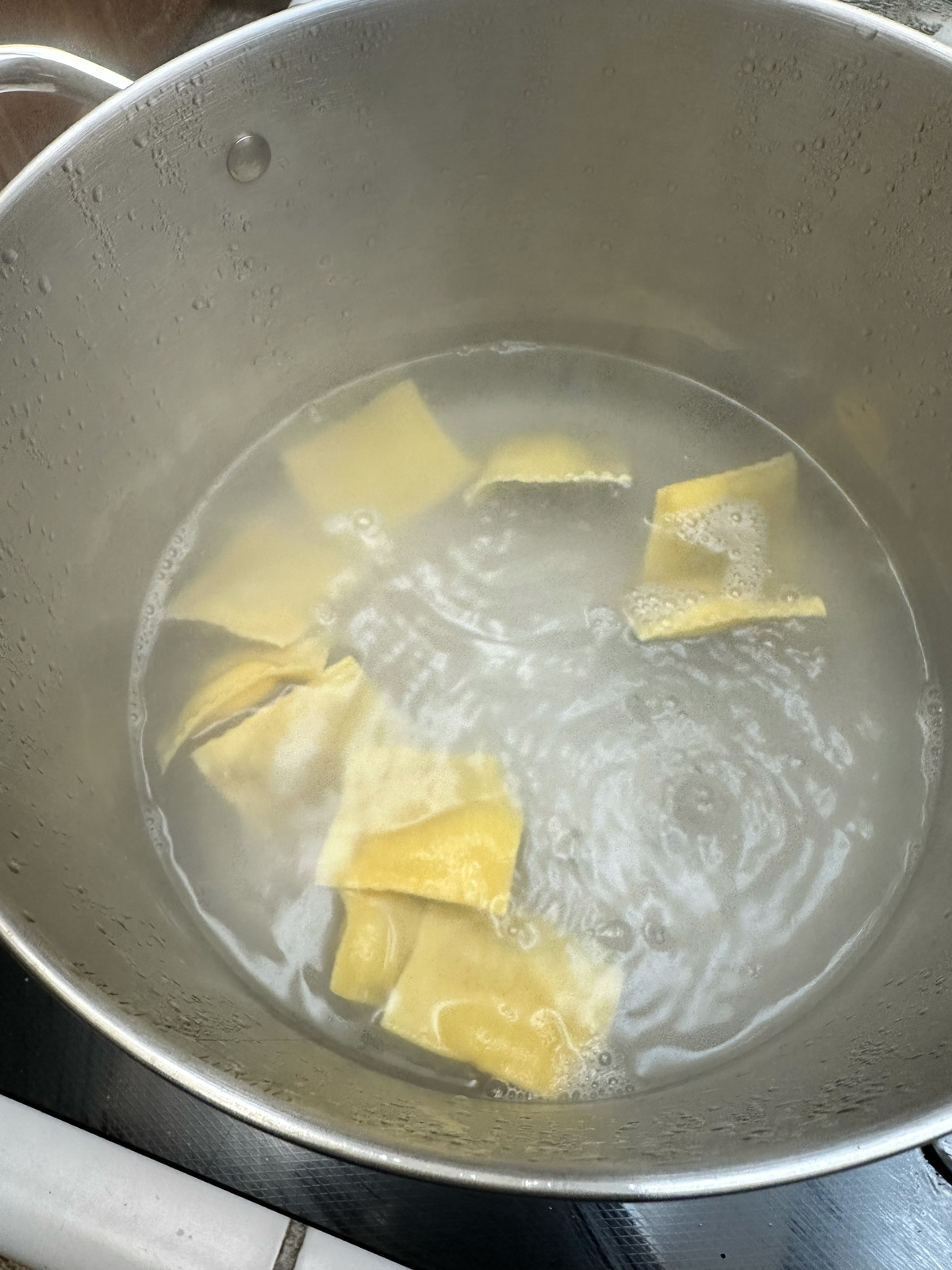
Unfrozen pasta cooks pretty fast — about three minutes or so, though I don’t time it. I just judge by how it feels against the stirring spoon. Fresh dough sort of goes from soft to stiff and back to soft again (but not too soft!). One other benefit of this method I noticed was that when one of the ravioli opens during the boiling process (which pretty much always happens, just hopefully not with too many of them), all that raw egg and meat in there seems to keep the filling from just leeching out into the boiling water. It gets more contact with the water but maintains its cohesive little ball shape. Which is nice.
I took them out with a slotted spoon and put them into a pan with some butter and a little pasta water (which makes a simple little pasta water-reduction kind of sauce). I added some black pepper and a little more grated parmesan.
At this point, probably the obvious question in choosing to put the filling in raw is, was that mere three minutes or so in the boiling water enough to cook the raw meat sufficiently that it was safe to eat?
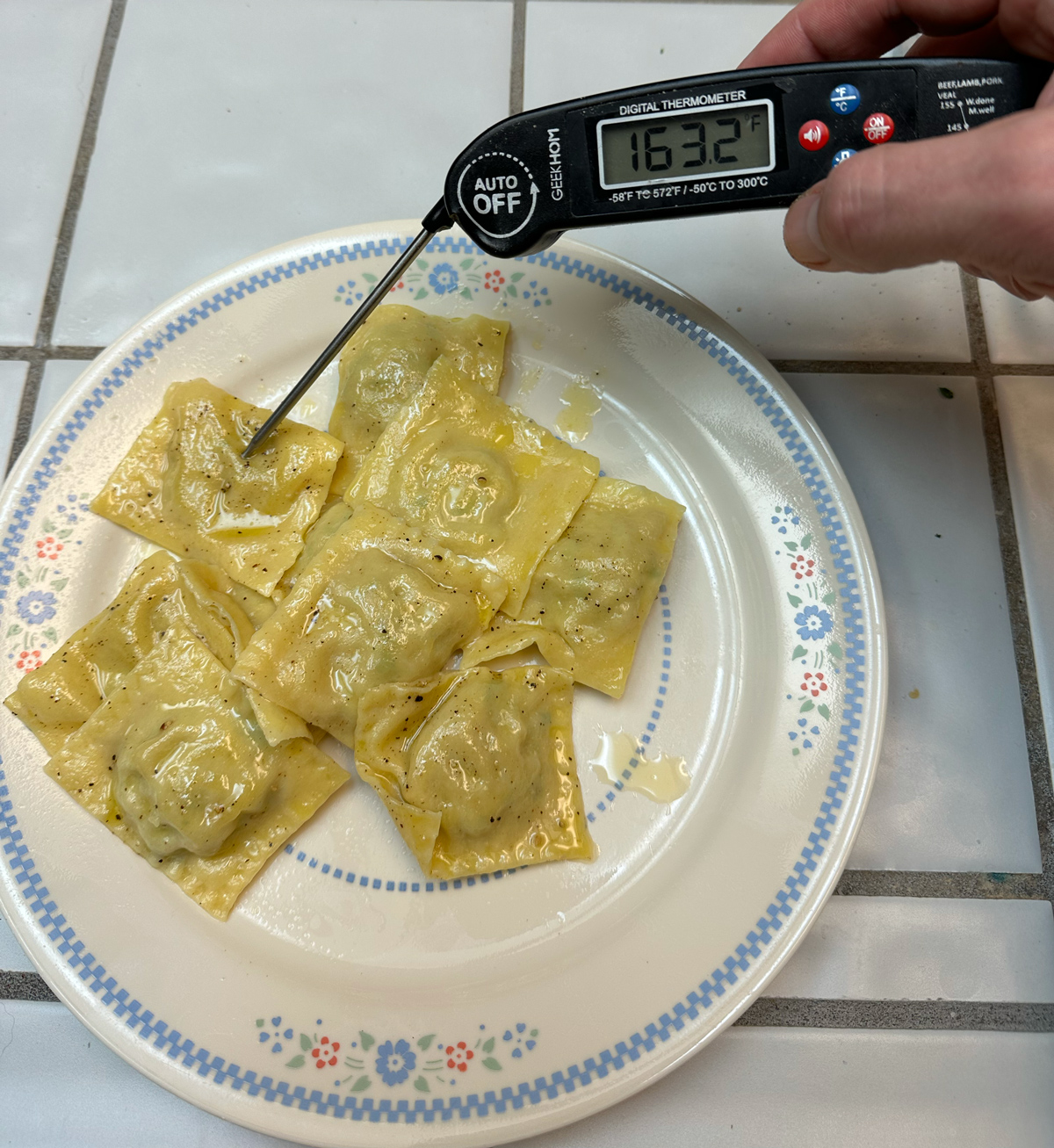
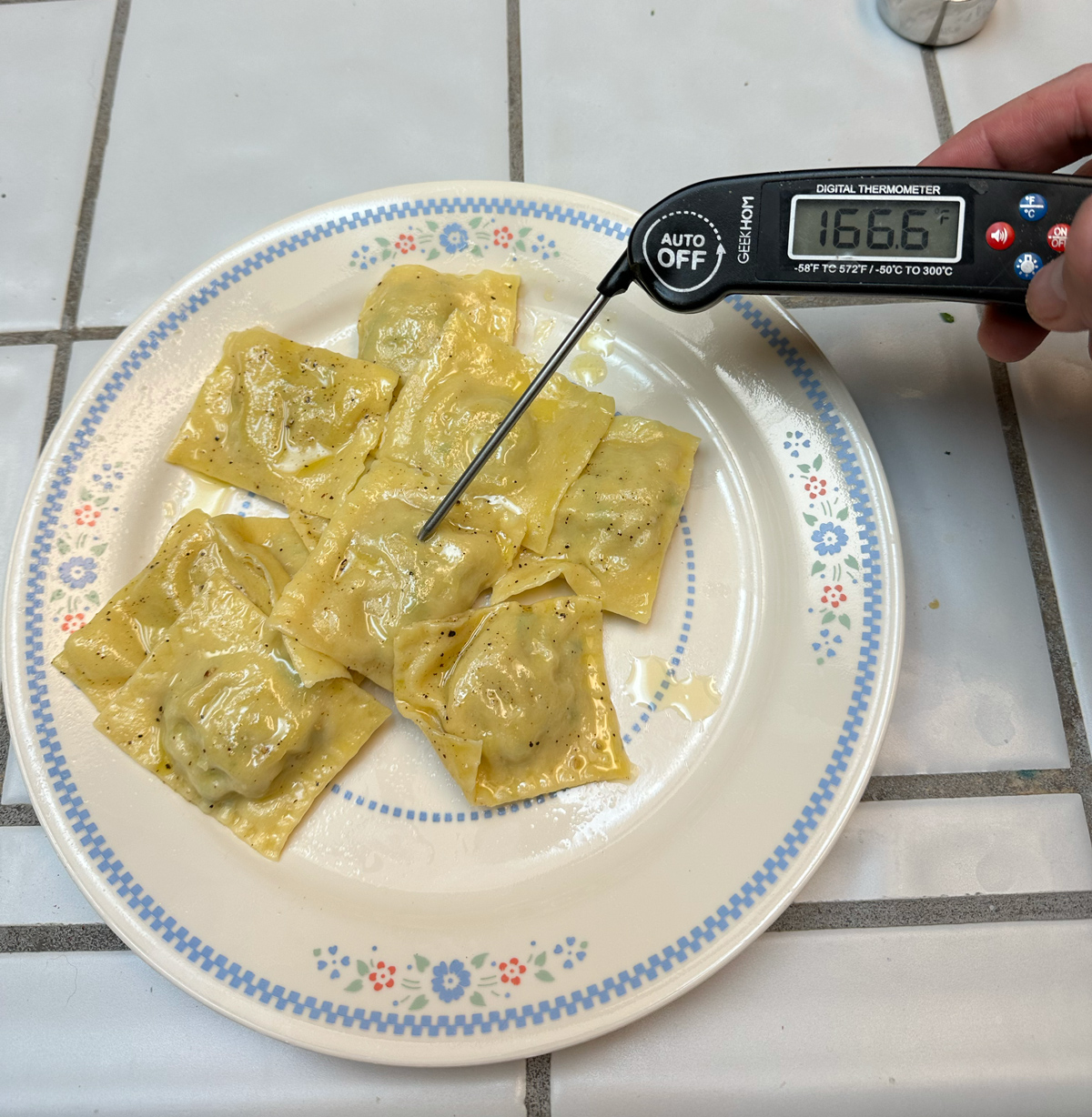
The FDA guidelines on ground beef (as well as veal, lamb, and pork) say that it should be cooked to 160 degrees Fahrenheit (71 degrees Celcius). According to my jabs with the meat thermometer, the meat filling was indeed over the legal threshold (and if you eat your hamburgers pink or red in the middle, as lots of people I know do, you’ve already been eating it at slightly less than that). In fact, it was pretty close to the ideal temperature.
Of course, ravioli vary in size, and whether it would cook at the same rate as the dough like this did in other ravioli would depend on the size of those ravioli, not to mention the thickness and moisture level of the dough. These were relatively small, with probably about a half tablespoon of meat in each. Bigger than that, you’d probably have to boil long enough for the pasta to start getting mushy and limp.
Probably the second most obvious question: were they any good? Obviously, you’ll have to take my word for it here, but upon first bite, I actually said, out loud, to myself, “holy shit.” The meat inside was juicy and delicious, like a freshly cooked tender meatball, and some of the fat from that meat had basically rendered through the dough, which also had a creamy coating of butter and pepper on the exterior.
I ran into the living room to feed one to my wife, and she concurred. In fact, she said, and I quote, “That’s one of the best things I’ve ever eaten.”
Anyway, these were good. That being said, I cooked them fresh. If you were making a big batch of ravioli for a special occasion, you’d probably have to freeze them, for the reasons outlined above. Frozen ravioli change the calculus a bit. In order to test that, I had to put some in the freezer and wait.
Frozen ravs obviously take longer to boil. For the frozen batch, the boiling process took 10 minutes or more. Of course, you need that longer boil time to defrost and then boil the raw meat filling. So, how’d we do?
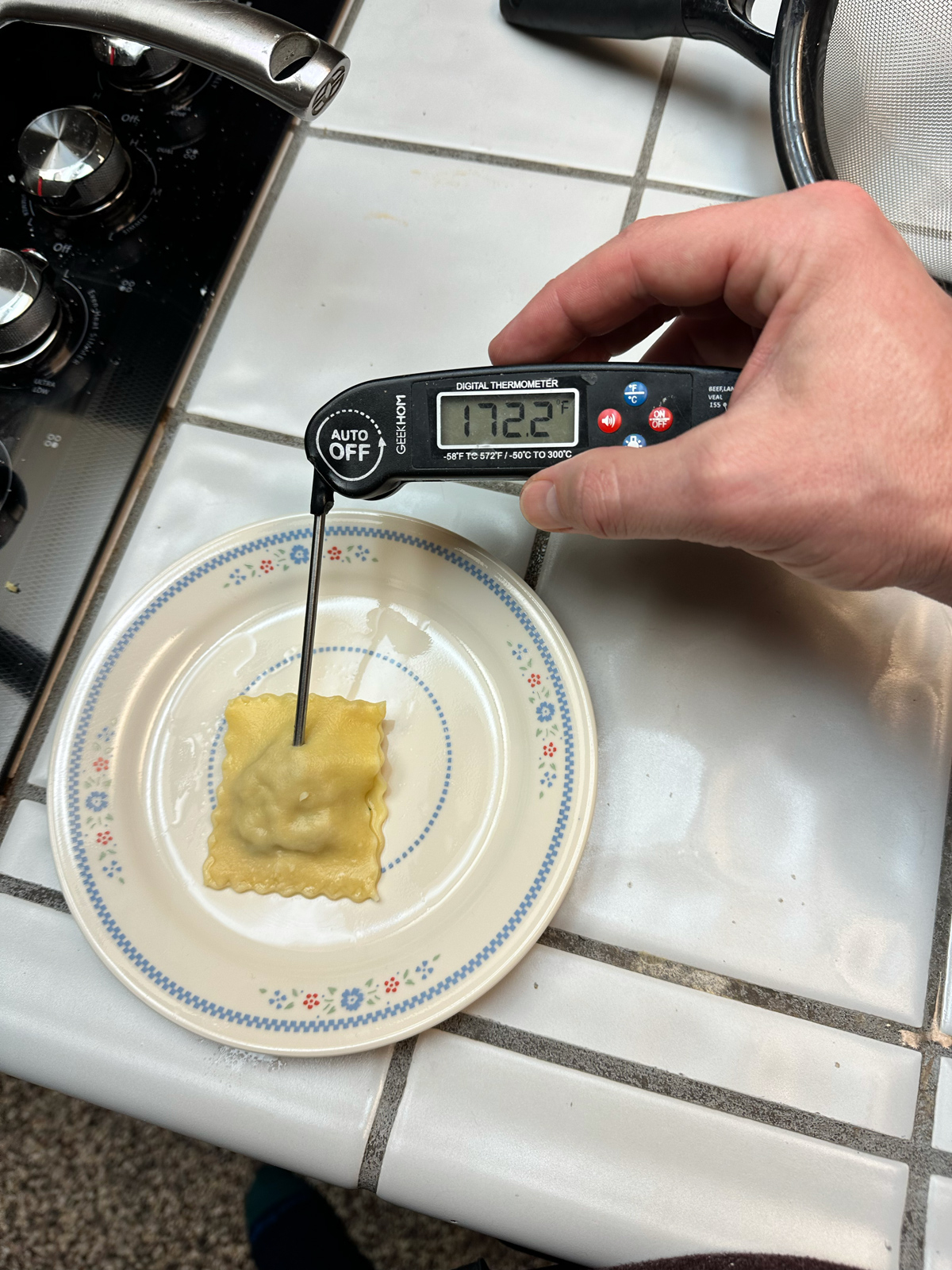
So far so good. The internal temp was actually higher than with the non-frozen batch. And that was before I added them to the sauce, which one would imagine would raise the temp even higher. I served this version with a simple tomato sauce:
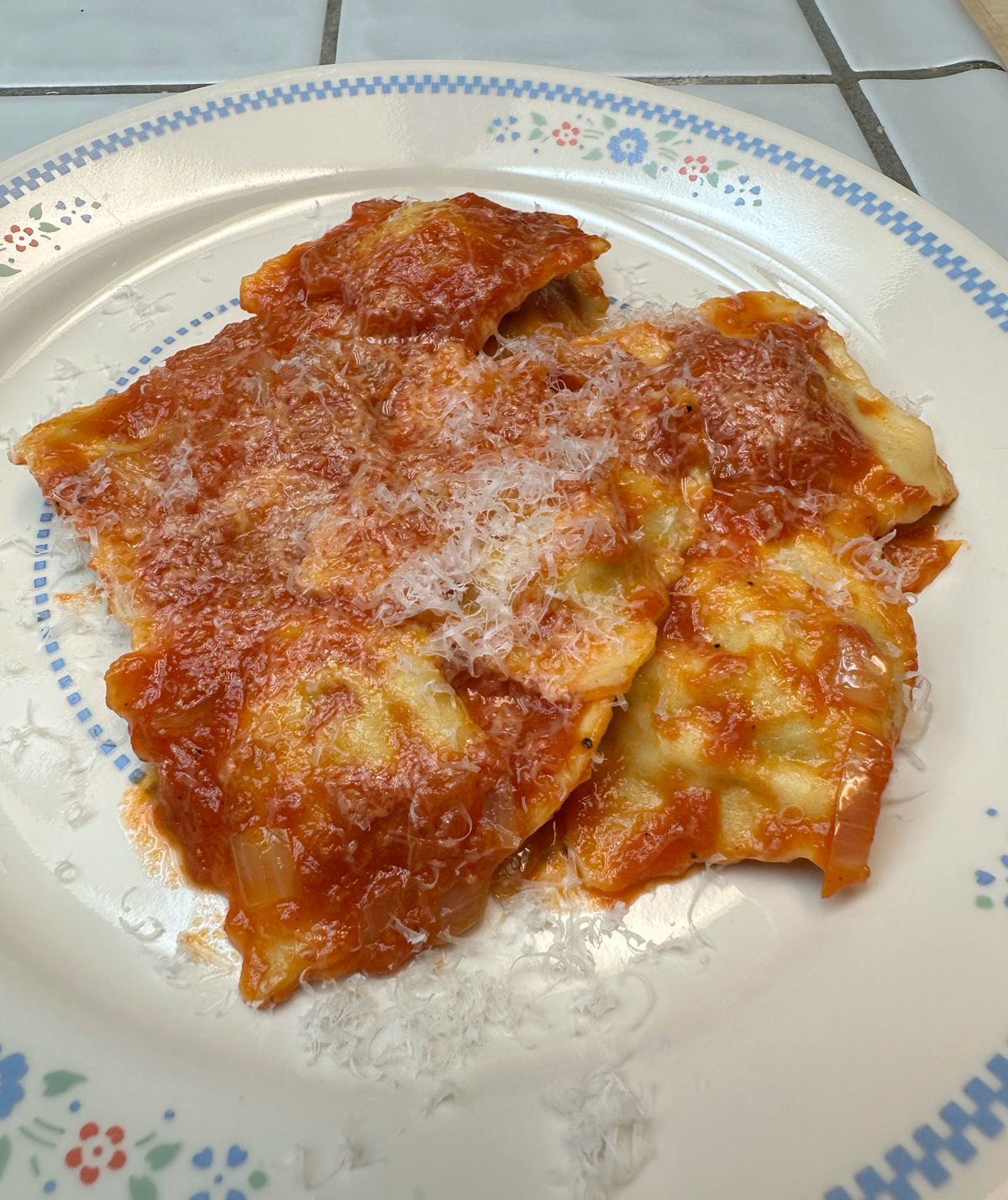
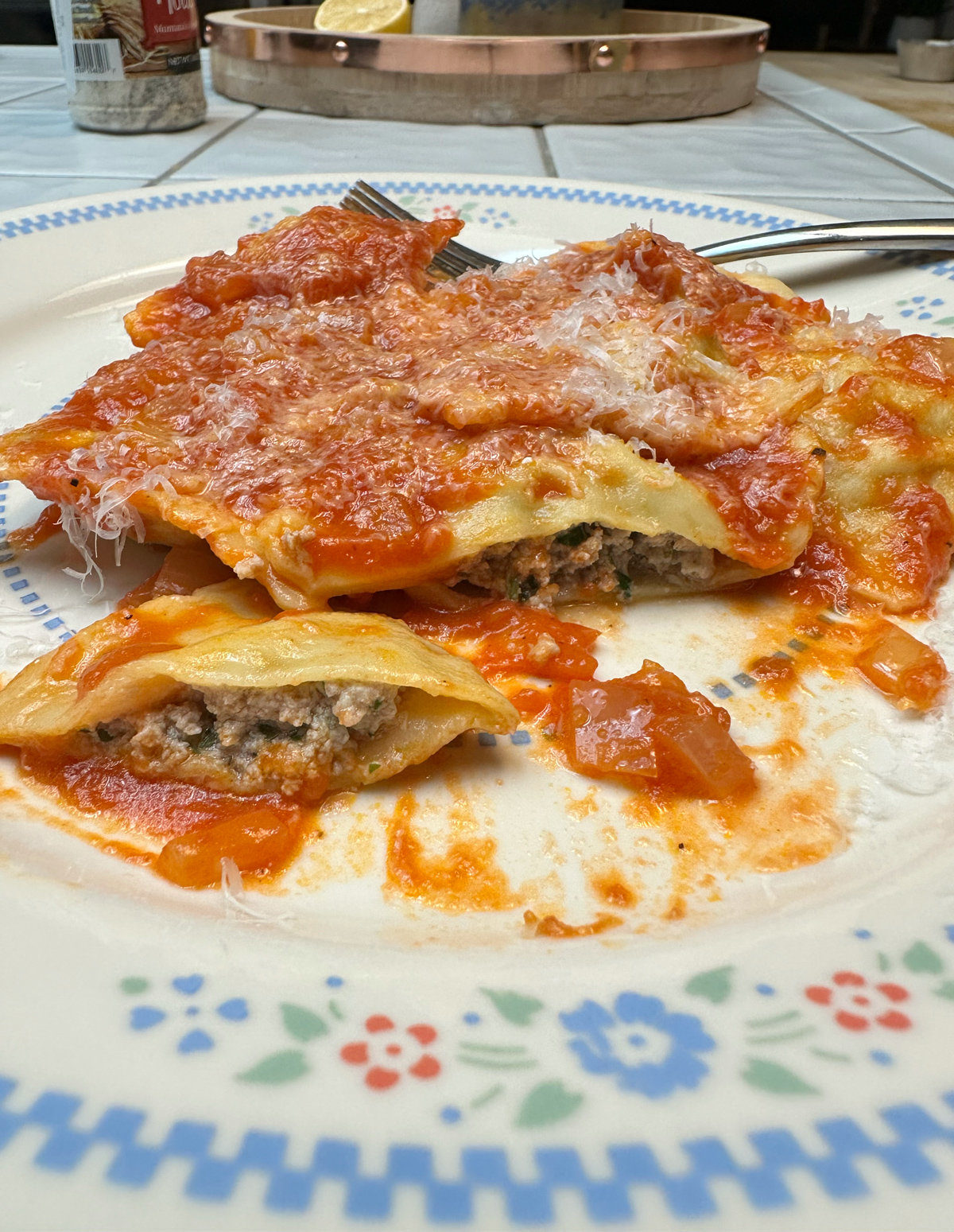
As for the taste, they were still great, though if I’m being honest, noticeably not as good as the fresh version. This even with more sauce. Presumably, this was due to the simple truism that frozen food just isn’t as good as fresh food. If you cook a hamburger pattie from frozen and cook one fresh, you’re going to notice a difference with that too. The meat isn’t as juicy, the fat doesn’t render out the same way, etc. Basically, the same factors seem to be at play here.
Having established that one certainly *can* make ravioli using frozen meat, what are the potential reasons for cooking the filling first?
- No size restrictions on the ravioli.
- Maillard reaction, aka char flavor. A boiled burger wouldn’t taste like a grilled one, and for the same reason, you could make a case that browned meat filling tastes better than non-browned. I didn’t necessarily find that here, but I could see that.
- The ability to season as you go. The major drawback of raw meat filling is that you have to cook a little bit of it when you want to test the seasoning level. Doesn’t seem like that big a deal, but that is an advantage.
Of all the reasons, the idea that you wouldn’t have to worry about ruining the pasta texture to get the filling cooked seems the most persuasive. As Joe Flamm explained it, “My assumption/thought/belief was always that because you cook dumplings longer, you use raw. Nobody eats al-dente shu mai. But pasta dough is thinner, so you have to cook the filling to get the right combo of just-cooked pasta and hot filling.”
Even though I had great results with my raw-filled ravioli, which also saves a fair amount of prep time (cooking plus chilling), it makes a certain sick sense that the Italians would come up with a dumpling method that prioritizes pasta texture above all else. These are the same people with the fanatical (some might go far as to say unhinged) obsession with “al-dente” dough, who refer to any pasta sauce as “the condiment,” etc.
Certainly, a matter of personal preference. I’ve been making these the same way for 20 years, but my initial results with raw filling have been positive enough that I’ll probably keep doing it that way, at least until I screw them up enough times that I go back to the old method.
All I know is, a filled dumpling is one of the highest forms of cuisine. If I’m trying an unfamiliar cuisine, I almost always go for the dumpling first. Whatever the culture, and whatever the dumpling, there’s inevitably a grandparent in the back filling those things with every flavor that can fit and lots of love. Dumplings pack more love per cubic inch than any other food.
—
Vince Mancini is on Twitter.
